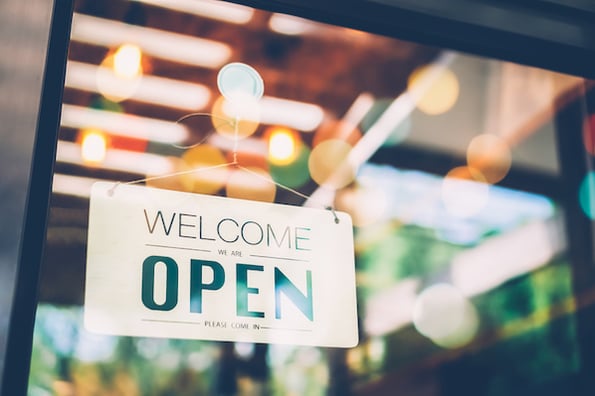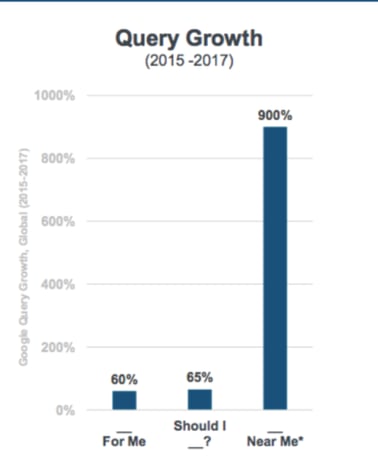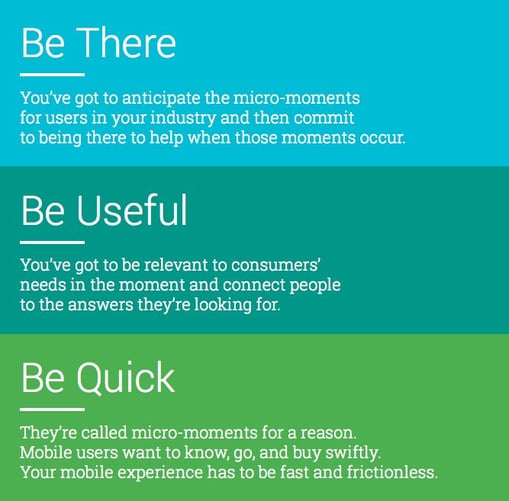Nowadays, voice-enabled devices such as Amazon Alexa and Google Home are becoming increasingly commonplace. Additionally, mobile searches for local services continue to rise, and by 2021, mobile devices are expected to influence $1.4 trillion in local sales.

All of which is to say -- people searching online for local services is now more prevalent than ever before.
If you haven't optimized your business for "near me" and voice-activated local searches, it's time you consider doing so. Here, we'll explore the importance of local SEO, how you can rank both on desktop and mobile for "near me" related searches, and how to optimize for voice search, as well.
Access Now: 21 SEO Myths to Leave Behind in 2021
The Rise of "Near Me" Searches
In the past two years, "Near me" searches have witnessed exponential growth, as highlighted in the stats below:
- There has been 150% growth for phrases like "near me now". For example "Pizza near me now".
- There has been a 900% growth for phrases like "near me tonight/today". For example "clubs near me tonight".
- There has been 200% growth for phrases like "now" + "near me". For example "stores open near me now".

Additionally, from 2013 to 2017 there was a 900% increase in "near me" searches:

Most users now have location or GPS enabled on their mobile devices -- and since most apps require this to be enabled, even users who previously had this turned off for privacy reasons now leave them on. This allows Google to automatically detect their current location and present the most relevant and localized search results to the user.
"Near me" searches are critical for marketers, since it allows you to reach your intended customers during micro-moments when they most desire your service or product.

As pointed out by Lisa Gevelber, Global VP Marketing, Google, "'Near me' searches are used to find a specific thing, in a specific area and in a specified period of time."
The rise of "near me" search queries with purchase intent are rising considerably. In fact, there has been a 500% growth in "near me" mobile searches that contain a variant of "can I buy" or "to buy" over the last two years.
Adding "near me" searches at the end of a search query demonstrates the user's eagerness to take immediate action on the search results. More than likely, the user intends on visiting a place to purchase a product immediately, or within the foreseeable future.
Now that we've explored the popularity of local search, let's dive into the top categories that correspond the most with "near me" searches.
Top 'Near Me' Query Categories
A survey conducted by Uberall tracked the responses of 1,000 smartphone owners and found around 82% of smartphone users had conducted a "near me" search between July 23 and July 27, 2018.
The hierarchy of the categories are given below:
- Food: 84%
- Entertainment: 56%
- Banking: 50%
- Apparel: 41%
- Persona care: 38%
From the survey, it's clear the maximum "near me" searches are conducted for food businesses, followed by entertainment and banking. However, apparel and banking businesses aren't too far behind. The results clearly show the intent of the searcher. If you're a business owner, then optimizing for "near me" searches is absolutely essential for the success of your business.
How Do You Optimize For "Near Me" Searches?
Optimizing your business for "Near me" searches is extremely crucial to increase your business presence in local search.
Here are some ways through which you can optimize your business for “near me” searches:
1. List your business on Google My Business and optimize it.
In order to get your business to the top of "near me" searches, you need to rank your business on local business results' pages, as shown in the screenshot below:

Maggiano's Little Italy is ranking on top of the local search results when searched with the query "Italian restaurants near me" -- but how?
In order to list your business in the local search results, you need to open a business account on Google My Business. Simply click "Start now" and follow the instructions provided to add your business on Google local.
It's equally important to follow the instructions below to properly optimize your business listing in the Google local search results:
- Enter your complete business name and business address.
- Add the complete direction to reach your business address using Google Maps. Follow this guide to edit your business details in Google.
- Add your business hours and contact details like phone number and website.
- Include your business in the correct category and be as specific as possible.
- Add photos of your favorite services.
- Ask people to leave reviews on your business page. More than 145 million people visit Yelp each month just to read the reviews left by other users. Reviews are a great way to filter the best businesses from the average ones, and Google always prefers to list the best businesses on top. Hence, if you wish to move your business to the top of the local search results then you need to acquire a ton of positive reviews for your business.
- Make sure the NAP (Name, Address and Phone Number) remains consistent on each of your business profiles scattered around the web, including social media sites like Facebook.
- Ensure your business information remains accurate, comprehensive and up-to-date.
Lastly, you'll want to add attributes like amenities your business offers, such as WiFi. For instance, have a look at the below screenshot that highlights the different amenities offered by the Marriott's Grande Ocean Hotel to its guests:

2. Use proper schema markup.
Schema markup is a great way to help your business stand out from competitors in the local search results. Schema data helps search engines acquire more information related to your business and present them in the form of rich snippets, which are immensely helpful for the user.
Have a look at the below screenshot, where proper holiday hours have been added in the business listing to avoid any confusion to the visitor. This information is added with the help of a schema markup:

Add schema markup to every location page that your business serves. The schema data should have the business address, hours of operation, and contact information.
Additionally, add the homepage schema markup to allow your business to show up in the Knowledge Graph and help ensure business information accuracy. An example of an organizational schema markup can be seen in the screenshot below:

Use this sheet to add local schema markup on your website. Remember to include only the information in the schema markup that you have displayed in the webpage.
3. Acquire backlinks having geographic anchor text.
Backlinks work well to improve your business rankings on Google local. In order to increase your business rankings for "near me" searches, you need to acquire high authority/relevant backlinks with geographically-rich anchor text.
For example, if you want to rank for "near me" searches for the location "Los Angeles" and for the category "bakery", then you need to use location rich variants of anchor text like "best bakery in Los Angeles", "bakery in Los Angeles", "Los Angeles bakery 3rd street", "LA bakery 3rd street", "cakes in 3rd street LA", "fresh cakes LA", etc.
4. Create pages targeting every location of your business, and optimize them.
If your business serves several locations then you need to create different pages for different locations. For example, if your bakery business serves five different U.S. cities including Los Angeles, Chicago, Washington, Boston, and Austin, then you need to create five different web pages serving each of these different cities.
Additionally, you need to optimize those web pages for "near me" searches by using the following tactics:
- Keep user-friendly URL structure for easier readability. For example, if you're advertising a bakery in Los Angeles, then name your page "www.mysite.com/LA-bakery''.
- Optimize the title and meta tags for your target keyword.
- Add proper alt tags and title tags to the images used in the web page. It's better if you provide an image of your bakery and use your location keywords in the alt and title tags of the image.
- Add a suitable description to your bakery and include store hours, your menu, store directions, and other amenities offered.
- Include a video of your store and add a video transcription to it. This way, you'll be able to increase the relevancy of your web page with respect to the specific location your business is serving.
Lastly, use internal linking wisely. You can link to different location-specific pages in the footer of your site with the anchor text "near me" in them.
For instance, have a look at the below footer from TripAdvisor, which links to location-specific pages and also uses the words "near me" in the anchor:

5. Make your site mobile-friendly.
Google prefers to return those sites in the search results that offer the best experience to the user. Making your site mobile-friendly and improving your overall site speed are some of the best ways to improve your site experience for users and rank higher for "near me" searches. Here are some of the best ways to make your site mobile-friendly:
- Make your site responsive so that the same content and experience is delivered to all the visitors regardless of the device they're using to visit your website.
- Improve your site speed and create AMP pages.
- Enable compression on your site by using Gzip.
- Use the search bar on your site to make it easier for people to look for information.
- Minify CSS, JavaScript and HTML.
- Reduce the number of redirects and remove render blocking JavaScript.
- Avoid using Flash as it degrades the user experience.
- Turn on auto-correct for forms and the search bar.
- Keep the button sizes large so that it becomes easier for the user to click on it.
- Leverage browser caching to improve your website loading time.
- Use the power of a CDN to distribute load so that your site loads even faster.
6. Create a blog and acquire local links.
Creating and maintaining a blog is one of the best ways to acquire local links. A blog lets you share articles on a regular basis, which allows users to remain updated about your business services when they subscribe to it.
A blog is a good way to earn local links -- and, additionally, it can persuade users to buy your products when they are in the "I want to know" phase of the customer journey.
You can conduct interviews with local influencers related to your niche and publish them on your blog. The influencers might link to your blog in return, which will help you acquire relevant links.
Additionally, you can conduct local surveys and publish the report regularly on your blog. This is an excellent way to earn authority back link.
If you have an informative list of queries where people are looking to find answers to their questions, then you can create blog posts that specifically answer the exact query of the users.
"Near me" Searches in the Era of Smart Devices like Alexa and Google Home
The sale of smart devices are rising considerably -- according to the National Public Media, there are around 43 million smart speaker users in the U.S. alone.
It's no surprise that people love to ask questions to smart devices, and a ton of those questions contain the "near me" phrase. Some example queries are:
- "Alexa, what movies are playing near me?"
- "Alexa, what bourbon events are near me?"
- "What’s a good sushi place near me?"
- "Alexa, what restaurants are near me?"
- "Okay Google, find a tire store near me"
- "Okay Google, find a hiking trail near me"
- "Okay Google, is Pizza hut near me open now?"
- "Where are ATMs near me?"
You need to prepare a list of queries that people might ask smart devices like Amazon Echo and Google Home. After that, you need to optimize your Google My Business profile by using the above six strategies so that it starts to rank on the top search results for your selected voice-related queries.
Business owners who get in early to the game of optimizing their website for "near me" searches, and for voice search, will be able to defeat their competitors in the near future. Both Amazon Echo and Google Home have begun showing users the convenience of using voice commands, so business owners need to find a way to get their business recommended by these smart devices.
If you haven't started optimizing your business for voice search and "near me" searches, then the time is just ripe to start doing so. Remember, the businesses who think ahead of their competitors and take efforts to keep their customers happy are able to generate maximum profits. Make use of the strategies discussed in this article to optimize your business for "near me" searches and satisfy your customers, both now and into the future.






![The Future of Google: Web Strategists Predict How AI Overviews & Other Search Changes Will Impact Traffic [New Data]](https://www.hubspot.com/hubfs/seo-sge-1-20241031-8247348.webp)

![SEO Step-by-Step Tutorial: 3 Essentials for Beginners [+ Next Steps]](https://knowledge.hubspot.com/hubfs/seo-tutorial-1-20240927-2646277.webp)

![The Evolution of Search: 5 SEO Trends in 2024 and 2025 [+ New Data]](https://www.hubspot.com/hubfs/evolution-of-search-1-20240809-1367247-1.webp)
